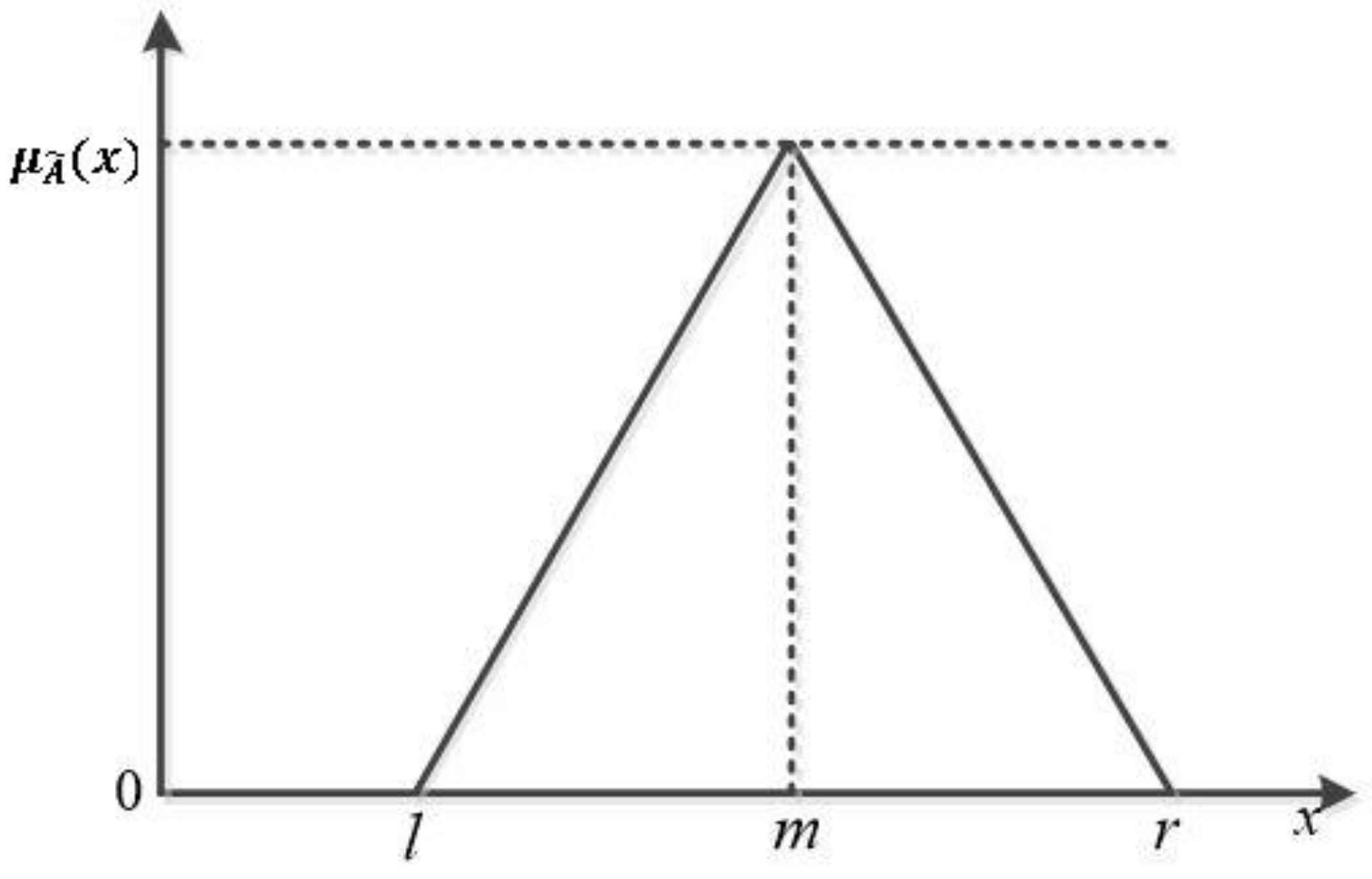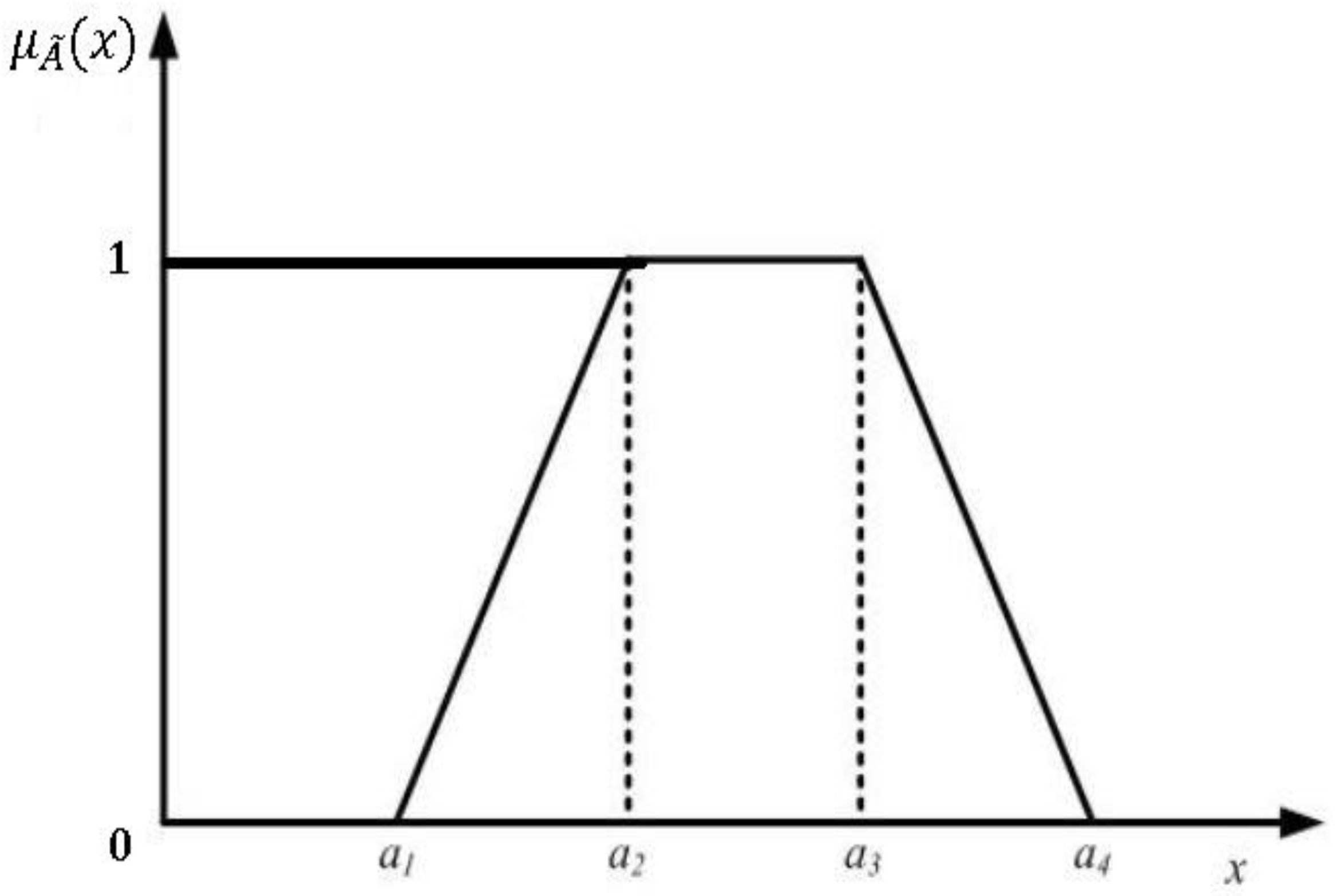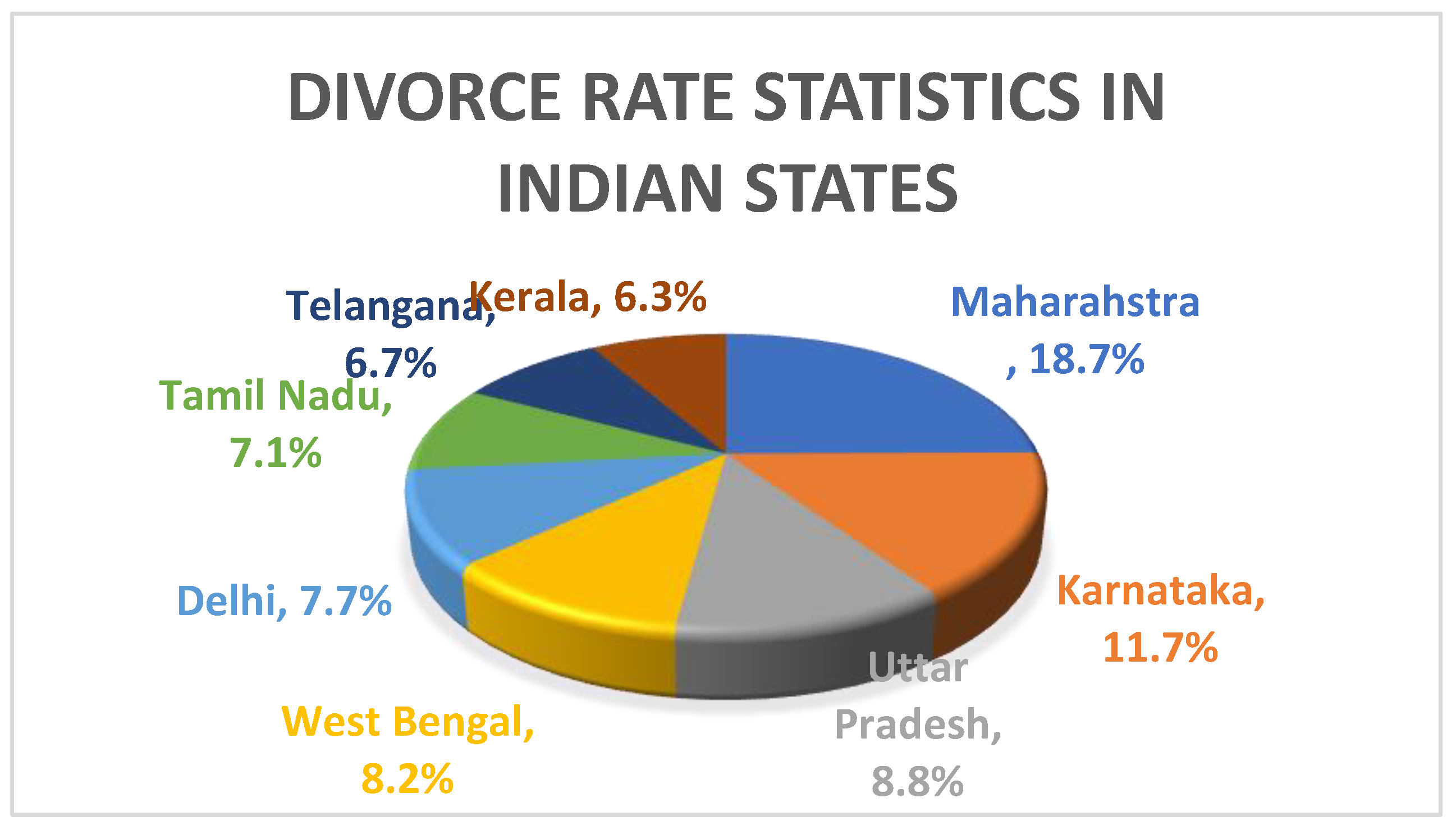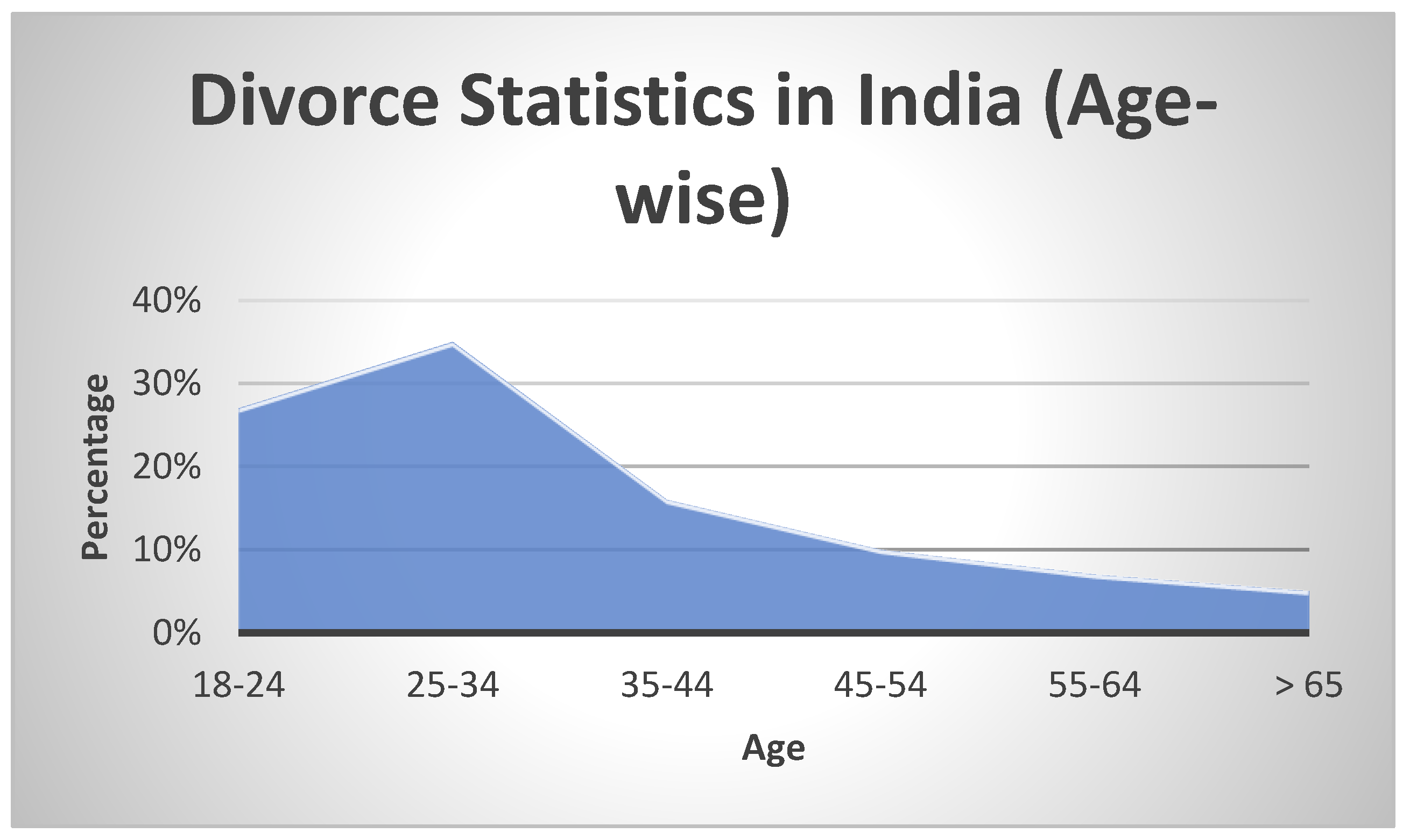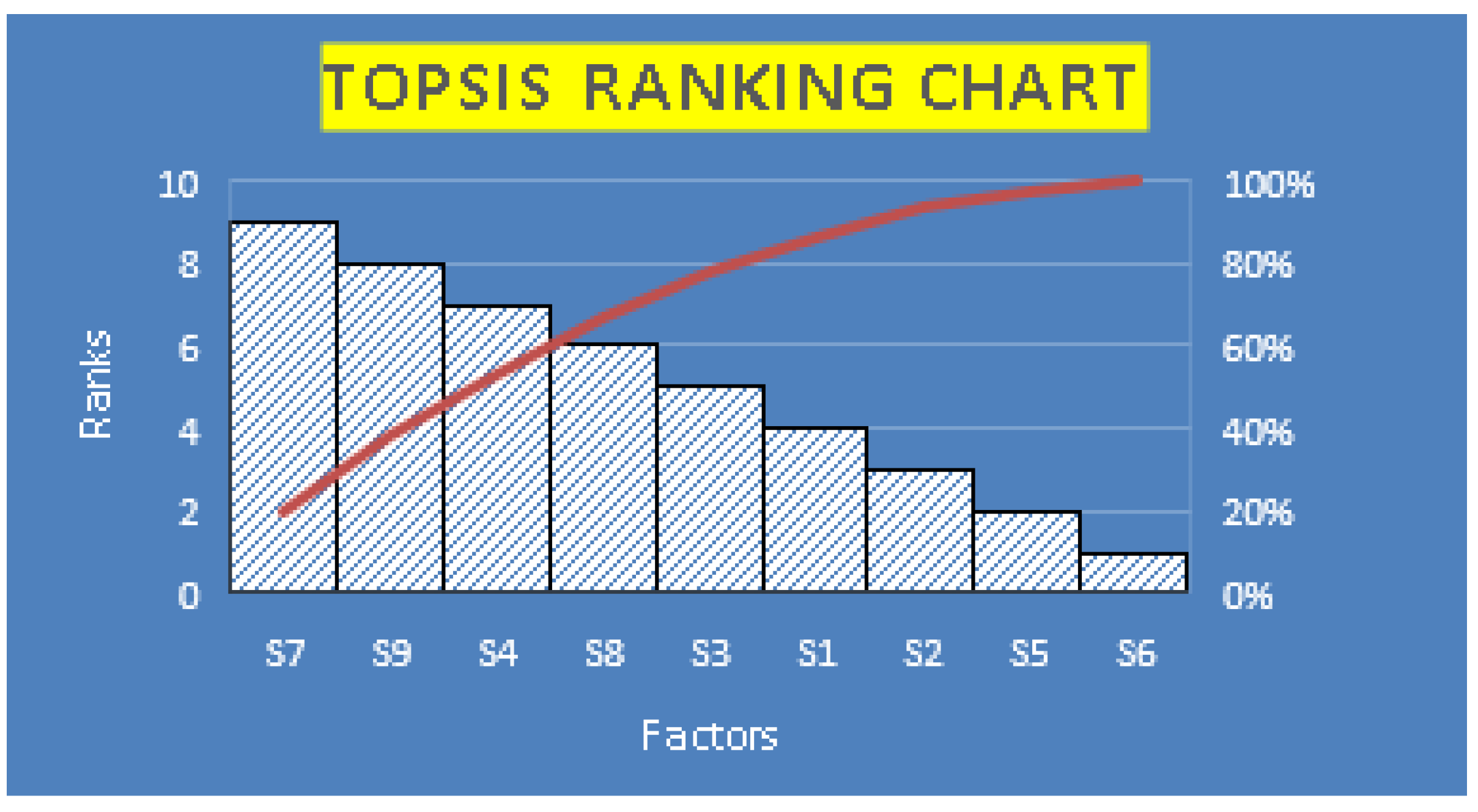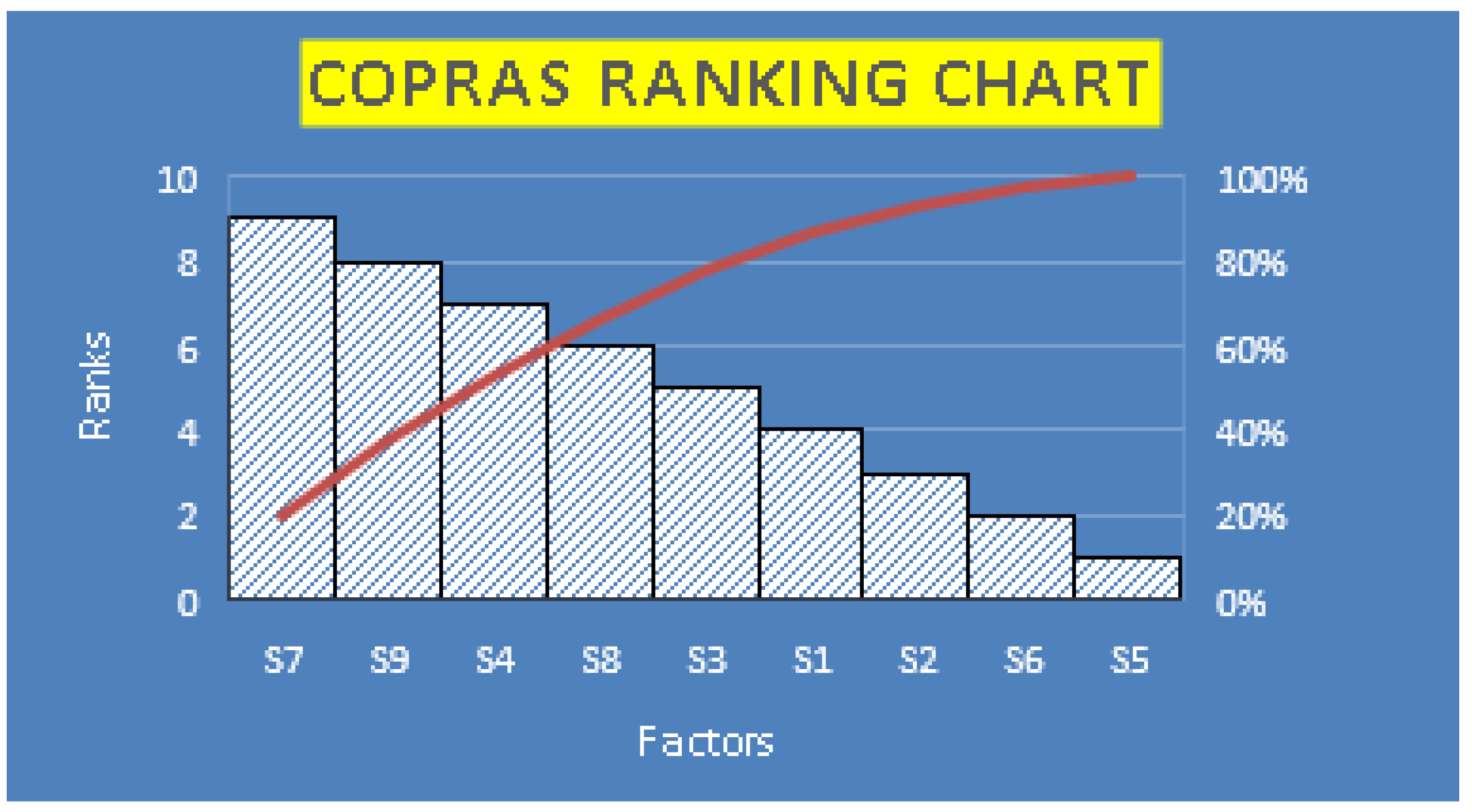1. Introduction
The divorce rate in India is increasing every year. It is estimated that the number of divorces has increased over the past 20 years due to many factors [
1]. India is a very culturally diverse country, and each state has something unique to its credit. One of the most debated topics in India is the state-by-state variation in divorce rates. In major cities, divorce rates exceed 30%. In several places, divorce petitions have practically tripled in recent years. It is observed that there are very few divorces and separations in northern states with patriarchal societies like UP, Bihar, Haryana, and Rajasthan. It is also observed that the northeastern regions have a higher-than-average divorce rate when compared to other regions [
2]. In India, women seek divorce at a higher rate than men do. The causes of the increasing divorce rate in India are mainly viewed as Lack of Communication, Financial Problems in the family, Emotional Break Down of Relationships, Lack of Trust, Unhappiness, Insecurity, Wanting to be independent, Erratic Work Schedule, Alcohol and smoking, etc., According to a recent study, the leading causes of this increase include adultery, ineffective communication between couples, unstable-finances, and incompatibility. Numerous variables, such as heredity, painful experiences in the past, stress, or even a person's lifestyle choices, can contribute to the depression of the couple. Sadly, depression can also be a significant factor in divorce in India [
3]. According to studies, couples who experience depression are much more likely to divorce than couples who do not. Couples who are depressed may have trouble communicating with one another, which can result in misunderstandings and arguments that may ultimately result in divorce. Additionally, a depressed spouse's lack of support can lead to emotions of abandonment or resentment, which furthers the tension in the marriage life. As they battle their mental health challenges, the depressed partner may occasionally even turn aggressive or abusive toward their spouse. More spouses are boldly filing for separation as the long-standing taboo of divorce is slowly dissipating. This is due to evolving views on marriage and family life, particularly in the younger generations. Divorce is now considered a chance to restore their independence and begin a new life [
4]. In addition, as women gain more autonomy over their lives, they do not hesitate to end unpleasant relationships when they believe there is no chance of a happy ending in their lives. Hence, the divorce rate has increased rapidly.
Divorce rate Statistics of the top 10 states of India in the past are shown in
Figure 1.
When gender is considered, 43.8% of males and 56.2% of females are seeking a divorce. That is, in India, more women than men are seeking divorce. When age is considered, most people looking for a divorce are between the ages of 25 and 34. This is observed from the following analysis, as shown in
Figure 2.
This article proposes to analyze the factors related to divorce and rank the most vital factors. The paper is structured as follows:
Section 2 presents basic definitions and arithmetic operations of triangular Fuzzy Numbers. In sections 3 and 4, replacement concepts and fuzzy replacement concepts are discussed, respectively. Also, the total cost of replacing the equipment at the end of each year is framed in a fuzzy environment. It is illustrated with a numerical example. In
Section 5, the conclusion is discussed.
2. Definition and Preliminaries
Definition 1.
A fuzzy set is a subset of a universe of discourse X, characterized by a membership function representing a mapping
The function value of
is called the membership value, which represents the degree of truth that x is an element of fuzzy set .
Definition 2.
A fuzzy set
defined on the set of real numbers R is said to be a fuzzy number, and its membership function : R→ [0, 1] has the following characteristics,
- (i)
is convex.
- (ii)
is normal if max .
- (iii)
is piecewise continuous.
Definition 3.
The α-cut of the fuzzy set
of the universe of discourse X is defined as = where
.
Definition 4.
A triangular fuzzy number [5] can be defined as a triplet (l, m, r) and the membership function
is defined as: where
l, m, r are real numbers and
.
Figure 3.
Triangular Fuzzy Number.
Figure 3.
Triangular Fuzzy Number.
Definition 5.
A trapezoidal fuzzy number [6] can be defined as and the membership function is defined as
where
are real numbers
Figure 4.
Trapezoidal Fuzzy Number.
Figure 4.
Trapezoidal Fuzzy Number.
3. TOPSIS and COPRAS Methods
3.1. Significant Concepts of TOPSIS
TOPSIS is expanded as a Technique for Order Preference by Similarity to the Ideal Solution. TOPSIS emerged as a multi-criteria-based decision-making technique in the 1980s. TOPSIS selects the option with the most significant distance from the negative ideal solution and the lowest Euclidean distance from the ideal solution. TOPSIS is a method for allocating ranks based on the importance and weights of the supplied elements. Weights indicate how much of a specific component should be considered (all factors have a default weight of 1). Using this strategy, machine learning models can be ranked according to various criteria, including correlation, R2, accuracy, and root mean square error. Nowadays, TOPSIS has many applications in various fields.
3.1.1. Literature Survey of TOPSIS
Fei et al.[
7] A novel, efficient, and workable representation of uncertain information, called D numbers, is proposed as a D-TOPSIS technique for the MCDM problem. The D-TOPSIS approach further expands upon the conventional TOPSIS method. The decision matrix provided by experts considering the interaction of several criteria is referred to in the suggested method as the D numbers theory. A human resources selection application is undertaken to show the efficacy of the suggested D-TOPSIS method, which is fundamentally a multi-criteria decision-making problem. Rahim et al.[
8] built a decision support system for selecting the best employees, which facilitated the decision maker in selecting the best choice based on standard criteria. They applied the TOPSIS method in their analysis. The following factors were considered while choosing the best employees: job responsibilities, work ethics, product quality produced by them and their behaviour. Top management always uses the universal significance value of the best employee candidates' final results to make the finest employee selection decisions. The Pythagorean fuzzy soft weighted average (PFSWA) and Pythagorean fuzzy soft weighted geometric (PFSWG) operators were introduced by Zulqarnain et al. [
9]. They also discussed their desired qualities. Additionally, a prioritization method based on correlation and weighted correlation coefficients was presented for order preference, resembling the ideal solution (TOPSIS) in the PFSS environment. The suggested methodology was used to create a decision-making method. A TOPSIS approach application for green supplier selection in green supply chain management (GSCM) was also provided. Comparative assessments from prior research demonstrated the suggested approach's usefulness, effectiveness, and adaptability. Initially, the research works of Cao and Xu[
10] were connected to the development of the multi-attribute decision-making method (MADM), which was closely related to investment in large-scale projects, were reviewed, and the pertinent approaches were sorted out. Following that, the enhanced vague-entropy-weight based fuzzy TOPSIS (VEWF-TOPSIS), entropy and interval language intuitionistic fuzzy sets-based TOPSIS (EILIF-TOPSIS), and information entropy attribute importance-based intuitionistic fuzzy TOPSIS (IEAI-IF-TOPSIS) methods were presented. A synthesis MADM method that thoroughly combines the three methods above was proposed. Finally, a numerical example was created to demonstrate the efficacy of the method suggested in their work, and recommendations were made for offering concepts and techniques for making decisions about large-scale project investments.
Through his research, Chakraborty[
11] compared two commonly used MADM methods—the TOPSIS technique and the modified TOPSIS approach—using comprehensive simulations and mathematical proofs. However, applying the weight incorporation method during the aggregation is not suitable. Evaluations have demonstrated the correctness of the reasons made for the modified TOPSIS. When the decision maker has not specified weight preferences, the objective weight elicitation idea in modified TOPSIS is valid and extremely helpful in comprehending tcriteria's significance and eliciting weights. However, because weight is squared throughout the aggregation process, how it is incorporated will result in faulty ranking. The TOPSIS method, which offers the proper weight aggregation procedure and should be employed for MADM issues where both TOPSIS and modified TOPSIS could be applied, has been demonstrated in the approach. Lamrini et al.[
12] described TOPSIS as one of the most popular MCDM techniques. Based on the Map Reduce paradigm, they presented a TOPSIS parallel implementation. Their technique would speed up the decision-making process and make it easier to promptly analyze the method's robustness and sensitivity in a high-dimension situation. Three multicriteria analysis issues were assessed to demonstrate the suggested approach's computational effectiveness and performance. Their research uses Google Cloud Platform's Dataproc service, which enables Apache Hadoop and Spark task execution. The tests they conducted yielded significant and encouraging results. Various researchers have carried out similar kinds of research using TOPSIS methods. [
13,
14,
15,
16]
3.1.2. Significant Concepts of COPRAS
The COPRAS method is expanded as the Complex Proportional Assessment method. Introducing the COPRAS approach made it possible to compare options and assess which one is better. This approach can be used to either maximize or minimize criteria in an evaluation where more than one criterion should be taken into account. The COPRAS approach allows for step-by-step ranking and evaluation of alternatives for importance and utility.
3.1.3. Literature Survey of COPRAS
To identify and categorize medical photos containing the new coronavirus, Albahri et al.[
17] propose a methodical evaluation and comparison of various artificial intelligence systems. The procedure made use of VIKOR techniques. Furthermore, weighting was done using the analytical hierarchy process (AHP). In the study by Vinodhini[
18], MCDM methodologies like the Weighted Sum Model (WSM), Weighted Product Model (WPM), Weighted Aggregated Sum Product Assessment (WASPAS), and TOPSIS were utilized, and regions were listed according to the control measures implemented to stop the spread of COVID-19. The precautionary measures implemented by Polish commercial banks to mitigate the potential adverse effects of the COVID-19 pandemic were evaluated by Korzeb and Niedzióka[
19] using the Hellwig and TOPSIS approach. Mishra et al.[
20] discussed an IVHFFSs environment decision analysis procedure using the traditional complex proportional assessment (COPRAS) methodology. The decision analysis approach for IVHFFSs was established and validated by the choice of desalination technology for treating the feed water. The assessment process considered several criteria and sub-criteria, and it was concluded that the technical, social, environmental, and economic aspects had the most influence on the choice of desalination technology. As a result of their research, reverse osmosis (RO), electrodialysis (ED), and multiple-effect distillation (MED) were shown to be the most suitable desalination technologies. A sensitivity investigation and comparative analysis were also conducted sensitivity investigation and comparative analysis were. Widely used multi-criteria decision-making techniques, namely the technique for order preference by similarity to ideal solution (TOPSIS) and complex proportional assessment (COPRAS), were applied by Kumar et al.[
21] to handle an LT selection problem. This study develops and evaluates a framework for selecting the ideal LTs for a manufacturing facility for automobile accessories that includes value stream mapping and plant architecture using the TOPSIS and COPRAS approaches. The computational complexity of the prior models was addressed by the LT selection framework provided in their study. It also separated the most and least desirable criteria, eliminating the need for criterion weight-generating techniques. Various researchers have carried out similar kinds of research using COPRAS methods. [
22,
23,
24,
25,
26]
4. Motivations and Contribution
The primary goal of this study is to pinpoint the critical causes of divorce in India. Using fuzzy MCDM models, the main contributing variables to the rise in divorce rates are ranked. The COPRAS technique ranks and evaluates options step by step for importance and utility. The TOPSIS technique assesses the options based on their distance from the positive ideal and the optimal solution. Given the strength of these two models, a hybrid decision-making system called TOPSIS and COPRAS was created by combining their key characteristics to identify the divorce risk variables that have the most impact on the general public.
Section 1 provides the fundamental data on India's divorce rate statistics.
Section 2 provides definitions and preliminaries.
Section 3 discusses the literature evaluation of TOPSIS and COPRAS methodologies.
Section 4 presents the fuzzy TOPSIS and COPRAS algorithms.
Section 5 provides examples of the suggested algorithm.
Section 6 includes the findings and discussions of the divorce-related factors. Section 7 presents a conclusion and recommendations for the future.
4.1. Proposed Algorithm–Fuzzy TOPSIS and COPRAS Hybrid Technique
4.1.1. Fuzzy TOPSIS
The alternatives and criteria were framed based on the factors leading to divorce.
Step-1
Constructed the Normalized Decision Matrix:
Transformed the various attribute dimensions into non-dimensional attributes, which allows comparison across the attributes using the equation Eqaution (3)
Step-2
Constructed the Weighted Normalized Decision Matrix:
Step-3
Determined Ideal and Negative-Ideal Solutions
Step-4
Calculated the Separation Measure:
Step-5
Calculated the Relative Closeness to the Ideal Solution
Step-6
Ranked the preference order – A set of alternatives can now be preference ranked according to the descending order of
4.1.2. Fuzzy COPRAS
The algorithm of the Fuzzy COPRAS method is discussed below:
Step-1
Constructed the fuzzy decision matrix with m rows and n columns
The Criteria matrix is constructed as follows:
Step-2
Constructed the normalized decision matrix with the following procedure:
Step-3
Constructed the weighted normalized decision matrix with the following procedure:
Step-4
In the COPRAS method, each alternative was described with its sums of maximizing attributes , i.e., the optimization direction is maximization, and minimizing criteria , i.e., the optimization direction is minimization n, where , k is the number of attributes to be maximized, and , where is the number of attributes to be minimized.
Step-5
Calculated the relative weight of each alternative:
5. Analyzing the Factors Causing Divorce through the Proposed Method
The main objective of this research is to identify the key factors influencing divorce. Therefore, the factors of divorce are ranked using decision-making models and analyzed in accordance with the decision-makers' perspectives. To examine the most severe causes of the rising divorce rate, TOPSIS and COPRAS techniques are used, each using 9 factors and 13 criteria.
Table 1 gives the factors pertaining to the increase in the divorce rate in India.
The number of years after marriage is considered a criterion for the divorce rate.
Table 2 gives the criteria for increasing divorce rates.
The linguistic variables and their triangular membership values are shown in the following
Table 3.
5.1. Analysis Using TOPSIS Method
Step 1: The linguistic direct relation matrices were constructed and transformed into triangular fuzzy matrices. Then, the aggregated triangular decision matrix T and weighted matrix W were constructed. For this analysis, the decision-makers' views are taken into account. Reviews are collected from experts such as lawyers, researchers, and common people. The fuzzy linguistic values provide the relationship between alternatives and criteria with the decision-maker's opinion. The Aggregated matrix of linguistic variables based on the decision-makers opinions on the factors and criteria is shown in
Table 4.
Step 2: The linguistic matrix was converted into a fuzzy decision matrix presented in
Table 5.
Step 3: The defuzzified matrix is normalized and depicted in
Table 6.
Step 4: The weighted decision matrix was determined and tabulated in
Table 7.
At this stage, the weighted normalized decision matrix (W) was established. The criteria weights were multiplied by the normalized decision matrix (U) total.
Step 5: The ideal best A
+ and ideal worst A
- were calculated through the equations Eqaution (4) and Eqaution (5) from the weighted matrix M and shown in
Table 8.
Step 6: The separation measure was determined. The Euclidean distance of each alternative from and was also obtained from the equations Eqaution (6) and Eqaution (7) by the TOPSIS method.
Step 7: The closeness coefficient to the ideal solution
was determined, and then the ranking of the alternatives was obtained from the equation Eqaution (8). The TOPSIS final ranking is described in
Table 9, and its corresponding ranking chart is displayed in
Figure 5.
Findings from the TOPSIS:
The TOPSIS method observed that the foremost serious factor influencing divorce is the family's financial problems. That is, money plays a vital role in the separation of couples. According to the TOPSIS technique, the top five factors leading to divorce are financial problems in the family, lack of communication, erratic work schedule, emotional breakdown of relationship, and want to be independent.
5.2. Analysis Using COPRAS Method
Step 1: The defuzzified matrix was normalized using the COPRAS technique, as in
Table 10.
Step 2: The weighted decision matrix was determined using the COPRAS technique, as shown in
Table 11. At this stage, the weighted normalized decision matrix (W) was established. The criteria weights are multiplied by the normalized decision matrix (U) total.
Step 3: Maximizing and minimizing index values were calculated using the COPRAS method. Maximizing index values are denoted by
, and minimizing index values are denoted by
.
Table 12 shows that all the considered criteria are maximizing (beneficiary) criteria.
Step 4: The relative weight of each alternative is calculated using the equation Eqaution (9). Then, the best C
i value is selected. According to the COPRAS technique, the factor influencing this is S
5, which is the lack of communication between the couples. Lastly, the performance value index (P
i) is obtained using the COPRAS method. The ultimate ranking of alternatives is given in
Table 13, and a ranking chart is presented in
Figure 6.
Findings from the COPRAS:
It was observed from the COPRAS method that the foremost serious factor influencing divorce is the lack of communication between the couples. That is, misunderstanding plays a vital role in the separation of couples. According to the COPRAS technique, the top five factors leading to divorce are ordered in the following manner: lack of communication, financial problems in the family, erratic work schedule, emotional breakdown of a relationship, and wanting to be independent.
Comparative Results:
| Method |
Top factors leading to divorce |
| TOPSIS method |
|
| COPRAS method |
|
6. Conclusion
This study aims to pinpoint the vital causes of divorce in India. In this study, 9 factors leading to divorce were considered. The number of years after marriage is considered a criterion for the divorce rate. Reviews were collected from experts like lawyers, researchers, and ordinary people. The aggregated matrix of linguistic variables was framed based on decision-makers opinions on the factors and criteria. Later, the linguistic matrix was converted to a fuzzy decision matrix. Using the two fuzzy MCDM techniques, TOPS, IS, and COPRAS methods, the severe causes of the rising divorce rate in India were analyzed. It is observed from the TOPSIS method that the foremost serious factor which influences divorce is financial problems in the family. That is, money plays a vital role in the separation of couples. The top five factors leading to divorce, according to the TOPSIS technique, are ordered in the following manner: financial problems in the family, lack of communication, erratic work schedule, emotional breakdown of a relationship, and want to be independent. It is observed from the COPRAS method that the foremost serious factor which influences divorce is the lack of communication between the couples. That is, misunderstanding plays a vital role in the separation of couples. According to the COPRAS technique, the top five factors leading to divorce are ordered in the following manner: lack of communication, financial problems in the family, erratic work schedule, emotional breakdown of a relationship, and the desire to be independent. The first and second factors only interchange in both methods; the other three factors in the top five influencing divorce have the same rank in the TOPSIS and the COPRAS methods. This study will help the researchers to use the above techniques to analyze the different factors in other domains. Through this study, the public can identify the reasons for the increase in divorces; this knowledge will help reduce the number of divorces in society.
References
- Thadathil, A., Sriram, S. (2020) Divorce, ‘Families and Adolescents in India: A Review of Research’, Journal of Divorce & Remarriage, Vol.61, No.1, pp.1–21. [CrossRef]
- Dommaraju, P., (2016) ‘Divorce and Separation in India’, Population and Development Review, Vol.42, No.2, pp.195–223.
- Vincent P., D’Mello L., (2018) ‘Changing Trends of Divorce in India: Issues & Concerns’, International Journal of Management, Technology and Social Sciences, Vol.3, No.2, pp.151–157.
- Faye, A., Kalra, G., Subramanyam, A., Shah, H., Kamath, R., Pakhare, A. (2013) ‘Study of marital adjustment, mechanisms of coping and psychopathology in couples seeking divorce in India’, Sexual and Relationship Therapy, Vol.28, No.3, pp.257–269. [CrossRef]
- Nagalakshmi, T., Uthra, G. (2018) ‘A new approach to find an optimal solution of a fuzzy linear programming problem by fuzzy dynamic programming’ International Journal of Engineering and Technology, Vol.7, No.4.10, pp.360-363.
- Nagalakshmi, T., Uthra, G. (2016) ‘Optimal solution to fuzzy cargo loading problem using generalized trapezoidal fuzzy numbers’, Global Journal of Pure and Applied Mathematics, Vol.12, No.1, pp.180-184.
- Fei, L. Hu, Y. Xiao, F. Chen, L. Deng, Y. (2016) ‘A Modified TOPSIS Method Based on Numbers and Its Applications in Human Resources Selection’, Mathematical Problems in Engineering, Vol.2016,6145196, pp.1-14. [CrossRef]
- Rahim , R. Supiyandi, S. Siahaan, A. P. U. Listyorini, T. Utomo, A.P. , Triyanto, W.A. Irawan, Y. Aisyah, S. Khairani, M. Sundari, S. and Khairunnisa, K. (2018) ‘TOPSIS Method Application for Decision Support System in Internal Control for Selecting Best Employees’, IOP Conf. Series: Journal of Physics: Conf. Series, 1028, 012052. pp.1-8. [CrossRef]
- Zulqarnain, R.M. Xin, X.L. Khan, W.A. (2021) ‘Aggregation operators of Pythagorean fuzzy soft sets with their application for green supplier chain management’, Journal of Intelligent & Fuzzy Systems: Applications in Engineering and Technology, Vol. 40, No. 3, pp. 5545–5563. [CrossRef]
- Chakraborty, S. (2022) ‘TOPSIS and Modified TOPSIS: A comparative analysis’, Decision Analytics Journal, Vol. 2, 100021, pp.1-7. [CrossRef]
- Cao, J and Xu, F. (2022) ‘Entropy-Based Fuzzy TOPSIS Method for Investment Decision Optimization of Large-Scale Projects’. Computational Intelligence and Neuroscience. Vol.2022, 4381293, pp.1-11. [CrossRef]
- Lamrini, L. Abounaima, M.C. & Talibi Alaoui, M. (2023) ‘New distributed-topsis approach for multi-criteria decision-making problems in a big data context’ Journal of Big Data, Vol.10, No.97, pp.1-21. [CrossRef]
- Parveen, N. Kamble, P.N. (2021) ‘An extension of TOPSIS for group decision making in intuitionistic fuzzy environment’, Mathematical Foundations of Computing, Vol.4, No. 1, pp. 61-71. [CrossRef]
- Barbat, S. Barkhordariahmadi, M. Kermani, V. (2022) ‘Extension of the TOPSIS Method for Decision Making Problems under Complex Fuzzy Data Based on the Central Point Index’, Advances in Fuzzy Systems, Vol. 2022, 1477098, pp.1-14. [CrossRef]
- Sadabadi, S.A. Hadi-Vencheh, A. Jamshidi, A. Jalali, M. (2022), ‘An Improved Fuzzy TOPSIS Method with a New Ranking Index’ , International Journal of Information Technology & Decision Making , Vol. 21, No.02, pp.615-641. [CrossRef]
- Ajripour, I. (2022) ‘Supplier Selection during the COVID-19 Pandemic Situation by Applying Fuzzy TOPSIS: A Case Study’, Acta Universitatis Sapientiae, Economics and Business, Vol.10, No.1, 3922, pp.91-105.
- Albahri O.S. Zaidan A.A. Albahri A.S., Zaidan B.B. Abdulkareem K.H. Al-Qaysi Z.T. (2020) ‘Systematic review of artificial intelligence techniques in the detection and classification of COVID-19 medical images in terms of evaluation and benchmarking: taxonomy analysis, challenges, future solutions and methodological aspects’, Journal of Infection and Public Health, Vol.13, pp.1381–1396.
- Vinodhini G.A.F. (2020) ‘Country ranking of COVID 19 using MCDM methods’. J Crit Rev, Vol.7, No. 5, pp.1333–1338.
- Korzeb Z. Niedziółka P. (2020) ‘Resistance of commercial banks to the crisis caused by the COVID-19 pandemic: the case of Poland’, Equilibrium. Quarterly Journal of Economics and Economic Policy, Vol. 15, No. 2, pp.205–234.
- Mishra, A.R. Liu, P. Rani, P. (2022) ‘COPRAS method based on interval-valued hesitant Fermatean fuzzy sets and its application in selecting desalination technology’, Applied Soft Computing, Vol. 119, 108570. [CrossRef]
- Kumar, M.B. Antony, J. Cudney, E. Furterer, S.L. Garza-Reyes, J.A. Senthil, S.M. (2023) ‘Decision-making through fuzzy TOPSIS and COPRAS approaches for lean tools selection: A case study of automotive accessories manufacturing industry’, International Journal of Management Science and Engineering Management, Vol. 158, No. 1, PP.26-35. [CrossRef]
- Chatterjee P. Athawale V.M. Chakraborty S. (2011) ‘Materials selection using complex proportional assessment and evaluation of mixed data methods’, Materials & Design, Vol. 32, No. 2, pp.851–860. [CrossRef]
- Majumder, P. Biswas, P. Majumder, S. (2020) ‘Application of New TOPSIS Approach to Identify the Most Significant Risk Factor and Continuous Monitoring of Death of COVID-19’, Electronic Journal of General Medicine, Vol. 17, No.6, em234.
- Alqahtani A.Y. Rajkhan A.A. (2020) ‘E-Learning critical success factors during the COVID-19 pandemic: a comprehensive analysis of e-learning managerial perspectives’, Education Sciences, Vol. 10, No. 9, pp.1-16. [CrossRef]
- Krishankumar, R. Garg, H. Arun, K. Saha, A. Ravichandran K. S. Kar, S. (2021) ‘An integrated decision-making COPRAS approach to probabilistic hesitant fuzzy set information’. Complex & Intelligent Systems, Vol. 7, pp.2281–2298. [CrossRef]
- Varatharajulu, M. Duraiselvam, M. Kumar, M.B. Jayaprakash, G. Baskar, N. (2022) ‘Multi criteria decision making through TOPSIS and COPRAS on drilling parameters of magnesium AZ91’, Journal of Magnesium and Alloys, Vol. 10, No. 10, pp.2857-2874. [CrossRef]
|
Disclaimer/Publisher’s Note: The statements, opinions and data contained in all publications are solely those of the individual author(s) and contributor(s) and not of MDPI and/or the editor(s). MDPI and/or the editor(s) disclaim responsibility for any injury to people or property resulting from any ideas, methods, instructions or products referred to in the content. |
© 2024 by the authors. Licensee MDPI, Basel, Switzerland. This article is an open access article distributed under the terms and conditions of the Creative Commons Attribution (CC BY) license (http://creativecommons.org/licenses/by/4.0/).
